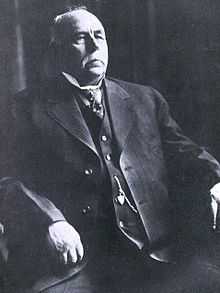Jesse Knight
| Jesse Knight | ||
|---|---|---|
 Jesse Knight ca. 1913 | ||
| Personal details | ||
| Born |
Jesse Knight September 6, 1845 Nauvoo, Illinois, United States | |
| Died |
March 14, 1921 (aged 75) Provo, Utah, United States | |
| Resting place |
Provo City Cemetery 40°13′23″N 111°38′38″W / 40.223°N 111.644°W | |
| Known For | Founding of Raymond, Alberta, Canada | |
| Residence | Jesse Knight House | |
| Spouse | Amanda Knight | |
| Children |
including: Raymond Knight Inez Knight Allen | |
| Parents |
Newel Knight Lydia Knight | |
|
| ||
Jesse Knight (6 September 1845 — 14 March 1921) was one of relatively few Latter-day Saint mining magnates in nineteenth century Western America. Raised by the widow of Newel Knight, Jesse's family was poor throughout his youth. As a young man, he worked as a prospector and discovered the Humbug Mine in the Tintic Mining District near Eureka, Utah in 1896. As the Humbug proved profitable, he acquired other mines in the vicinity, including the Uncle Sam, Beck Tunnel, Iron Blossom, and Colorado mines. After making his fortune, Knight went on to found the Latter Day Saint settlement of Raymond, Alberta, Canada.
Biography
Knight was born in Nauvoo, Illinois to prominent Mormons Newel and Lydia Knight. When Jesse was a one-year-old, his family was forced to flee Nauvoo as Mormon pioneers under the leadership of Brigham Young. Jesse's father died in Nebraska on the Mormon Trail in January 1847; his mother and eight siblings continued on but were not able to reach their Salt Lake Valley destination until early 1850.
Knight is significant in Western American mining and entrepreneurial history because in several important ways he differed from the typical "robber baron" capitalists of the late-nineteenth century Gilded Age. His success, like theirs, depended upon the skillful acquisition and management of such business variables as claims, labor, capital, technology, and government services, and also upon the development of cost-efficient integrated enterprises, such as the Knight Investment Company. However, he also owned more patented mining claims in the Intermountain West than did his counterparts, and he was not inclined to engage in stock manipulation like many other mining entrepreneurs and railroad barons. Moreover, his business methods, especially when dealing with his working men, were far more paternalistic and benevolent than those of the typical big businessmen of the era. While other company town and mine owners often exploited their workers, Knight treated his workers very fairly in his company town of Knightsville, Utah, which he equipped with a meetinghouse, amusement hall, and school instead of the usual hedonistic establishments of mining camp life.
Although Knight's philanthropy was not unique for the period, his generous gifts to Brigham Young University (an interest he shared with his wife, Amanda) earned him the reputation as the "patron saint" of BYU. He also gave freely to The Church of Jesus Christ of Latter-day Saints and to many church-related projects. Furthermore, his comfortable but unostentatious home in Provo, Utah, did not rival the extravagantly garish mansions built by big businessmen from San Francisco's Nob Hill to New York's Fifth Avenue. Nor did he seek high political office like mining kings George Hearst, James Fair, William Sharon, John P. Jones, Nathaniel Hill, Jerome B. Chaffee, Horace Tabor, William Clark, or Utah's Thomas Kearns—all of whom served in the "millionaire's club" of the United States Senate.
Knight was known by the moniker "Uncle Jesse" during his lifetime due to his image as rich but giving uncle. In his writing, he expressed a belief that his money was for the purpose of doing good and building up his church; he regarded the matter as a "trusted stewardship." As he once said, "The earth is the Lord's bank, and no man has a right to take money out of that bank and use it extravagantly upon himself." Although he strayed from the LDS Church in his early years and briefly affiliated with the anti-Mormon Liberal Party in Utah, he was a devout member for most of his life and helped to save the LDS Church from financial ruin incurred from legal battles with the federal government over control of the Utah territory and issues such as polygamy.
After making his fortune in mining, Knight went on to develop settlement and industry in what is today southern Alberta. In 1901, Knight purchased 30,000 acres (120 km²) of land in Canada's Northwest Territories for $2.50 per acre. On this property he established a ranch; Knight later went on to acquire another 226,000 acres (915 km²) of land near his ranch and established a town built around irrigation farming of sugar beets, which were then processed in a local sugar factory that Knight built. The settlement was named Raymond in honor of his son, Raymond Knight. Within five years, over 1,500 Latter-day Saints—mostly from Utah—had immigrated to Raymond. The town incorporated in 1903, and today Knight is honored as the founder of Raymond, Alberta.
-

Knight Mansion - built 1905 in Provo, UT
-

Knight Block built 1900 downtown Provo, UT
See also
References
- Peterson, Richard H., Utah History Encyclopedia, http://www.media.utah.edu/UHE/k/KNIGHT,JESSE.html
- Jesse Knight at Find a Grave
- Turner, ed., Lawrence (1993). Raymond Remembered : Settlers, Sugars and Stampedes : A History of the Town and People of Raymond. Town of Raymond. pp. 3–31 to 4–38. ISBN 0-9697655-0-9.
|